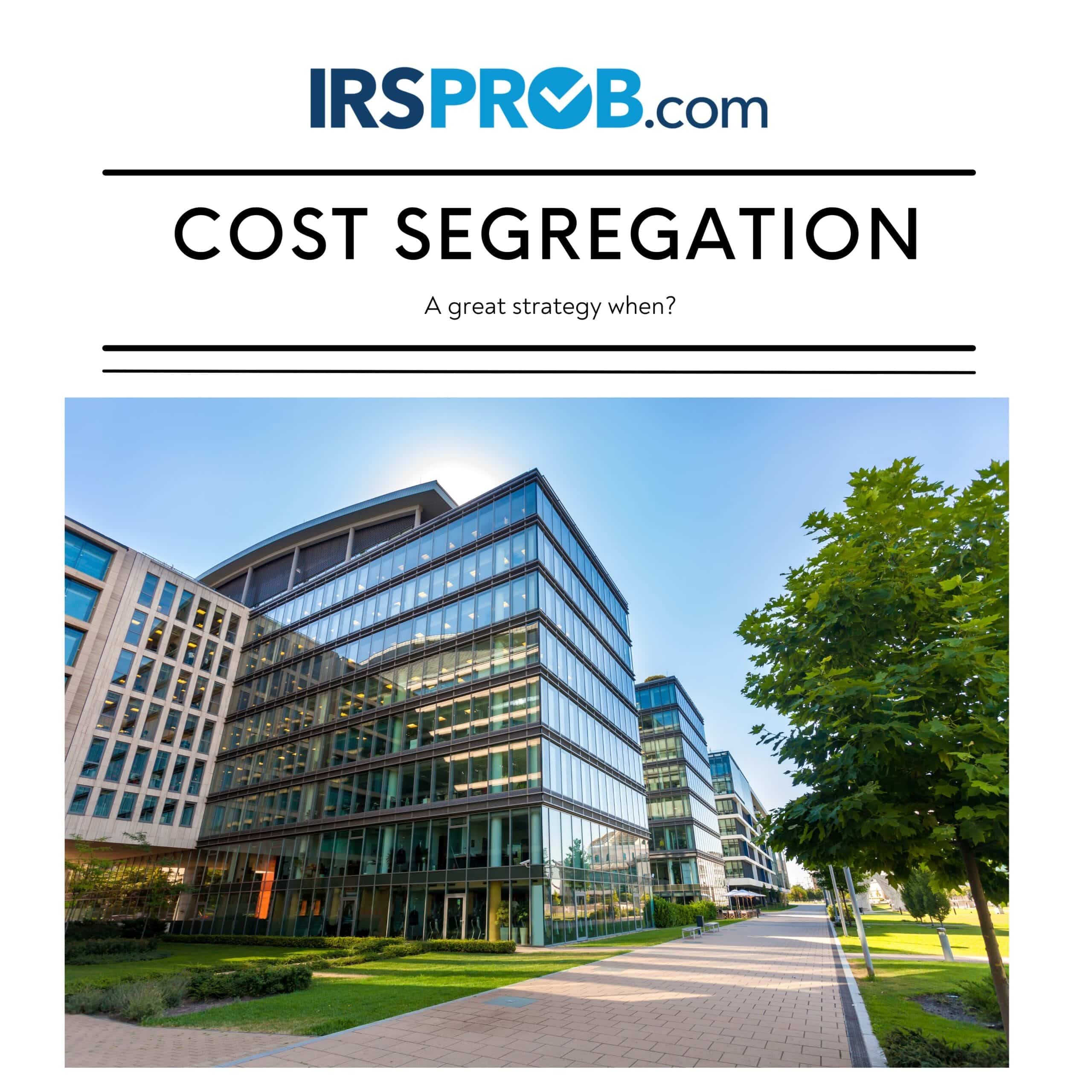Cost Segregation: A Great Strategy When?
One of the greatest tax benefits of owning residential rental property or non-residential commercial or investment property is depreciation—a deduction you get without spending any additional money.
Sadly, regular depreciation for real property is slow, taking anywhere from 27.5 years to a whopping 39 years. But fortunately, there is a way you can speed up your depreciation deductions—especially during the first year or years you own your property: cost segregation.
What Is Cost Segregation?
When you purchase non-residential real property or residential rental property, you ordinarily pay a single lump sum to the owner, but you are actually purchasing more than one asset. Real property consists of:
- The Land: The building sits on, as well as any other surrounding land included with the purchase.
- Land Improvements: Such as landscaping, swimming pools, paved parking areas, and fences.
- The Building Itself: The structure you purchased.
- Personal Property Inside the Building: Items not considered building components, for example (in residential rentals), refrigerators, stoves, dishwashers, and carpeting.
Most property owners depreciate all these items together (excluding the land, which is not depreciable). Residential rental property is depreciated over 27.5 years, while commercial property has a 39-year depreciation period. Both use the straight-line depreciation method—the slowest form of depreciation.
But you have the option of depreciating each asset type separately. The technical name for this type of depreciation is “cost segregation.” Personal property and land improvements have much shorter depreciation periods than commercial or residential buildings and building components, so you can depreciate them much more quickly. Personal property has a five- or seven-year period, while land improvements are depreciated over 15 years.
Your total depreciation deduction won’t be any different, but you’ll get it much quicker using these shorter depreciation periods for some of the cost of your property. And there’s more.
The Power of the Tax Cuts and Jobs Act (TCJA)
In the past, cost segregation merely enabled you to deduct personal property over five or seven years instead of 27.5 or 39 years, and land improvements over 15 years. But the Tax Cuts and Jobs Act (TCJA) supercharged cost segregation by allowing property owners to deduct the full cost of such property in a single year. It did this in two ways:
- 100% Bonus Depreciation: From 2018 through 2022, the full cost of personal property and land improvements in rental property could be deducted in a single year.
- Section 179 Expensing: Starting in 2018, Section 179 expensing became available for personal property contained in residential rental units.
Moreover, bonus depreciation and Section 179 may be used for both new and used property. This means a property owner may purchase from a third party a used commercial or rental property and deduct the cost of the personal property and land improvements with Section 179 and bonus depreciation.
The Phasing Out of 100% Bonus Depreciation
The TCJA scheduled the 100 percent bonus depreciation break to begin phasing out after 2022. If Congress does not act, the bonus depreciation percentage will be 80 percent for 2023, 60 percent for 2024, 40 percent for 2025, and 20 percent for 2026. On the good news front, Section 179 remains available indefinitely to deduct the full cost of personal property up to annual limits. Section 179 differs from bonus depreciation in two important ways: there is both a dollar limit and a profit limit on Section 179. Your Section 179 deduction may not exceed your annual profit from all your businesses, and it is subject to a $1,160,000 limit for 2023 and $1,220,000 for 2024.
Practical Example: The Benefits of Cost Segregation
Typically, 20 percent to 30 percent of the value of commercial and rental property (not counting the land) consists of personal property and land improvements. So, with Section 179 and at least 80 percent bonus depreciation, your first-year depreciation/expensing deduction could be enormous.
Example: Alan purchases in 2023 a small rental home for $120,000. He determines the value of the land to be $20,000, so the building has a $100,000 depreciable basis. If Alan uses regular depreciation, he must deduct the $100,000 basis over 27.5 years. His annual depreciation deduction is $3,485 the first year and $3,636 for years two through 27.
If Alan uses cost segregation, he can deduct the cost of the home’s personal property and land improvements much more quickly. He determines that the home’s appliances have a $3,000 basis, the flooring a $5,000 basis, and the property’s fence a $7,000 basis. If bonus depreciation is at 100 percent, he can use it to deduct the total cost of all these items the first year, providing a $15,000 first-year deduction.
Alan uses regular depreciation for his remaining $85,000 basis, providing a $2,962 deduction the first year. His total first-year deduction is $17,962. Thereafter, his annual regular depreciation deduction is $3,091.
If bonus depreciation is less than 100 percent, Alan can use Section 179 expensing to deduct the total cost of the appliances and flooring, and bonus depreciation to deduct 80 percent of the cost of the fence. Again, he gets a substantial first-year deduction.
The Necessity of a Cost Segregation Study
A cost segregation study of some kind must be conducted to identify which elements of a building are personal property and land improvements and then determine their depreciable basis. Neither the IRS nor the courts have established any mandatory requirements or standards for cost segregation studies. But the IRS has issued a detailed cost segregation audit guide regarding such studies.
Potential Drawbacks of Cost Segregation
Before you go ahead with cost segregation, you should be aware that this process has some potential drawbacks:
- Passive Loss Rules: Your enhanced depreciation may not result in any extra tax savings because of the passive loss rules.
- Depreciation Recapture: You’ll have to pay back your enhanced deductions when you sell your property—a process called “recapture.” And this recapture payment on the segregated assets comes at ordinary income rates.
- Like-Kind Exchange Limitation: You may not be able to use a like-kind exchange to defer tax on the personal property you deducted using cost segregation.
Passive Loss Rules
The first-year depreciation deductions that property owners may take using cost segregation can easily result in a loss for the year. You’ll get no immediate benefit from such a real estate loss if you can’t deduct it because of the passive loss rules. These rules prevent owners of real estate rentals from deducting losses in excess of their passive income. The rules also apply to non-rental activities in which an owner does not materially participate. There are exceptions to these rules for real estate professionals and for losses up to $25,000 incurred by moderate-income property owners.
But this doesn’t necessarily mean you should forget about doing a cost segregation study anyway. Rental losses you’re unable to deduct are not “lost.” Instead, they become suspended passive losses that you may use in any future year you have sufficient rental income (or other passive income) to offset them. If you are not able to use the losses, you’ll be able to deduct them when you sell the property—but at this point there will be no benefit from a cost segregation study. If you expect to have sufficient rental or other passive income to offset these losses in the near future, a cost segregation study may still be worthwhile. But if you doubt you’ll have sufficient passive income to soak up your losses for some time, if ever, a study may be a waste of time and money.
Depreciation Recapture
The benefits gained from cost segregation may be minimal or nonexistent if you don’t plan to keep the property for at least five years. This is because of depreciation recapture. When you sell your property, you’ll have to recapture the depreciation you’ve previously taken on the personal property it contains and pay tax at ordinary rates on it.
Like-Kind Exchanges
One way to avoid the recapture problem is to do a tax-deferred like-kind exchange instead of a taxable sale. With a like-kind exchange, the basis of the old property is shifted to the new, with no depreciation recapture. But as a result of the TCJA, starting in 2018, like-kind exchanges are allowed only for real property, not personal property. So, you could still have depreciation recapture (at ordinary income rates) on the gain of the personal property you’ve separately depreciated.
The IRS has issued detailed regulations on what constitutes real property for purposes of Section
1031 like-kind exchanges. Fortunately, the IRS adopted a broad definition of real property that includes most items identified in a cost segregation study that are affixed to a building. Such affixed personal property items are eligible for a like-kind exchange. In addition, if the exchange involves movable personal property, such as furniture, and the fair market value of the personal property is 15 percent or less of the aggregate fair market value of the replacement real property, the personal property does not trigger recapture—it’s simply part of the exchange.
The IRS Cost Segregation Audit Technique Guide
The IRS has created a detailed guide to cost segregation for its auditors that is also available to educate the public. It provides a valuable overview of the topic and gives guidance on cost segregation studies—these are the key to cost segregation. The IRS guide notes that there are many different ways to do such a study, and they vary in cost and quality.
Types of Cost Segregation Studies
Cost segregation studies fall into two broad categories: engineering-based (conducted by construction engineers) and non-engineering-based.
Engineering-Based Cost Segregation Studies:
- Detailed Engineering from Actual Records: This method uses cost information from construction and accounting records. Engineers examine each component of the property to determine its depreciable life and then allocate costs accordingly. The IRS considers this to be the gold standard of cost segregation studies. It also takes the longest and costs the most—anywhere from $5,000 to $20,000.
- Detailed Engineering Cost Estimate Approach: This method is similar to engineering from actual records, but it uses cost estimates instead of actual costs. It’s used where cost records are not available, which is often the case for used property.
Non-Engineering-Based Cost Segregation Studies:
These are cheaper than engineering-based studies, but the IRS does not consider them to be as reliable. There are at least four types:
- Survey or Letter Approach: This type of study involves contacting contractors and subcontractors to ask for specific information on the cost of assets they installed on the project. The survey or letter approach is ordinarily doable only for newly constructed property.
- Residual Estimation Approach: The costs of the five-, seven-, and 15-year assets are added together and then subtracted from the total project cost.
- Sampling or Modeling Approach: A cost segregation company creates a statistical model of building component costs by analyzing multiple similar properties. Property owners can complete an online questionnaire and obtain a cost segregation study based on the sample and on proprietary algorithms that assign costs to a building’s components. Such online studies can cost just a few hundred dollars and may be the best choice for lower-cost properties.
- Rule of Thumb: These studies are based on the preparer’s experience and industry averages. They use little or no documentation. The IRS considers such studies suspect—but it doesn’t prohibit using them.
The IRS considers engineering-based cost segregation studies to be the most reliable. It does not require any particular type of study or methodology. The most important thing is to adequately substantiate your depreciation deductions and property classifications. Substantiation using actual costs is always best. Where estimates are the only option (as with most used property), the methodology and source of any cost data should be clearly documented.
Deciding what type of cost segregation study to do depends primarily on the value of the property involved. The expense of an engineering-based study may be justified only if the property is worth $750,000 or more (not counting the value of the land). You can use online cost segregation calculators to get an idea of the amount of your accelerated tax deductions with a study.
Timing Your Cost Segregation Study
The best time to perform a cost segregation study is usually the same year that you buy, build, or remodel your real property. You’ll ordinarily spend the most money on your real estate the first year, so you’ll reap the most tax savings. You don’t have to use cost segregation the first year you own real property. You can wait until a future year—perhaps when you have enough rental or other passive income to make use of the speeded-up depreciation deductions.
In the year you do the study, you deduct the difference between what you originally claimed as depreciation on your property and what you could have claimed had you performed your cost segregation study earlier. With the later-year study, you generally must use IRS Form 3115 to request a change in accounting method. This type of change is ordinarily granted automatically by the IRS, and you don’t need to file any amended tax returns.
Under IRS rules, you are allowed to perform a look-back study on properties that you bought, built, or remodeled as far back as January 1, 1987. But the benefits are minimal for older buildings that have been mostly depreciated already. Cost segregation experts say that a rental property acquired less than 15 years ago is a good candidate for a cost segregation study.
Takeaways
Here are five takeaways from this article:
- Depreciation Periods: Residential rental property is depreciated over 27.5 years and non-residential real property over 39 years, providing a relatively small deduction each year. But property owners have the option of using cost segregation to separately identify, value, and depreciate the personal property and land improvements contained in their property.
- Accelerated Deductions: Using cost segregation does not increase a property owner’s total depreciation deductions, but it does accelerate them over the first few years because personal property has a five- or seven-year depreciation period and land improvements have a 15-year period. In addition, by using bonus depreciation and/or Section 179 expensing, owners can deduct all or most of the cost of personal property and land improvements the first year—providing a potentially enormous first-year deduction.
- Cost Segregation Study: A cost segregation study of some kind must be conducted to identify which elements of a building are personal property and land improvements and then determine their depreciable basis. Neither the IRS nor the courts have established any mandatory requirements or standards for cost segregation studies. But the IRS has issued a detailed cost segregation audit guide discussing such studies. Studies can be conducted by engineers or done more cheaply with other methods that the IRS views as less reliable.
- Potential Drawbacks: Some property owners may not benefit much from cost segregation—for example, where it results in a loss that can’t be deducted by the owner due to the passive loss rules, or where the owner intends to sell the property within a few years and has to recapture the depreciation deductions.
- Timing: The best time to perform a cost segregation study is usually the same year that you buy, build, or remodel your real property. But the cost segregation can be done at any time. The year when you do the study is the year you deduct the faster depreciation.








